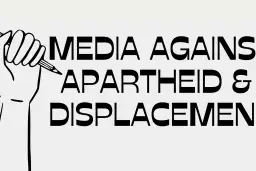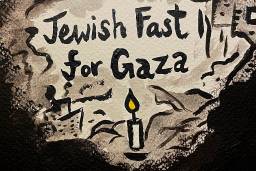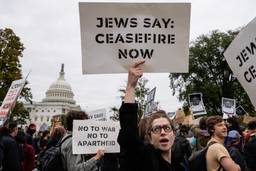On July 9, the International Court of Justice (ICJ) in The Hague ruled in favor of the Palestinians in their case against the construction of the wall dividing Israel from the West Bank. In an advisory opinion, the ICJ harshly criticized Israel, demanding that they tear down the wall, compensate Palestinians harmed during its construction, and begin negotiations for a separate Palestinian state “as soon as possible.” The ruling came in a 14 to 1 vote, with the sole American judge as the lone dissenter, who maintained Washington’s position that the conflict is a political, and not legal, dispute.
June marked the two-year anniversary of the construction of the wall, the barbed wire and bulldozer rubble stretching along the Israeli-Palestinian border. Now 114 miles long and expanding at an accelerating pace, the wall is beginning to snake through Jerusalem, cutting off main roads, severing Palestinian neighborhoods and preventing Palestinians from commuting. As planned, the wall strays far from the pre-1967 “Green Line,” the border established by the 1949 Armistice Agreement at the end of the Arab-Israeli War. The current plan places 50 percent of the West Bank in Israeli hands, isolates pockets of Palestinians in the middle of Israeli communities and loops around important sites like Rachel’s Tomb.
The barrier constitutes the biggest change to Jerusalem’s map since 1967. In Jerusalem alone, the wall would leave 60,000−80,000 Arabs outside the city limits, cut off from economic activity. Wall construction is also gathering speed in rural areas. Bulldozers moved into Gaza in May, and on June 6, Israel began blocking side roads between Ramallah and Jerusalem to prepare for building. June also saw the initiation of barrier construction around the West Bank villages of Zawiya and Rafat, with bulldozers moving into neighboring village Deir Ballut at the end of the month. Upon completion, the wall will entirely enclose the three villages, creating a single ghetto.
Although joint coalitions of Israelis and Palestinians have succeeded in halting progress at a few sites by appealing to Israel’s Supreme Court, these injunctions usually expire after a month, leaving the areas open for construction again. The court does not have the jurisdiction to suspend construction of the entire wall, though on June 30 it did approve a petition to re-route 25 miles of the Jerusalem wall, taking Palestinian neighborhoods into consideration, but the Israeli District Coordinating Office claims it has the authority to go forward with construction in the areas where it has already begun.
“The government’s armies are accelerating work in every place where there is no injunction,” says Adam Keller, a spokesperson for Gush Shalom, an Israeli peace organization dedicated to reinstating the green line. He emphasizes that the wall’s progress impacts Palestinians doubly. “Every inch of the wall that goes deeper means one more Palestinian losing his land and livelihood,” says Keller. “But it also has a larger political side: it makes the possibility of a viable Palestinian state less likely.”
According to Jamal Juma, coordinator of the Palestinian Environmental NGO Network and leader of the Anti-Apartheid Wall Campaign, the wall would displace 550,000 Palestinians, cutting them off from their land and homes. It would isolate 343,000 more within ghettos, separating them from other Palestinians and forcing some to relocate. The barrier’s route frequently divides communities in half. In the Palestinian suburb of Anata, where construction began June 24, the border even runs through individual houses: half a house may be considered part of the West Bank, while the other half is part of Jerusalem. Such arbitrary divisions also mean separation from vital resources. If the barrier is completed, Juma says, Palestinians will lose 95 percent of their water sources.
Proponents of the wall argue that it is a temporary measure necessary for “security reasons.” Barry Rubin, director of the Global Research in International Affairs Center, notes that terror attacks have decreased dramatically in the northern parts of Israel where the barrier is complete.
“The fence is an essential part of a new security system which does not require an in-depth presence in the West Bank,” Rubin says. In fact, he adds, most of the wall’s supporters hail from the left side of Israel’s political spectrum, and view the wall as a step toward a two-state solution.
Indeed, the vast majority of Israelis support construction of the wall. Yet Juma attributes this attitude to misinformation. Mainstream Israeli news sources like the Jerusalem Post and Haaretz, much like those in the U.S., have barely covered the situation in the West Bank in recent weeks.
“The majority of people here are in favor of the wall, because they see it in a simple way: I am here, suicide bombers are out there, let’s build a wall to make sure they can’t come in,” Keller says.
Anti-occupation activists are working to spread information about the wall in both Israel and Palestine. Recent weeks have seen a rise in site-specific demonstrations, in which unarmed villagers and their allies physically block the bulldozers on their land. Major demonstrations are occurring daily in the West Bank villages of Zawiya and Deir Ballut, as well as in Ar Ram, a Palestinian suburb of Jerusalem, where construction is now occurring. On June 5, the 37-year anniversary of the occupation, Palestinians and Israelis joined to march against the wall on the road between Ramallah and Jerusalem.
Palestinians have been waiting for an ICJ ruling on the wall since February. Catherine Cook, a senior analyst at the Middle East Research and Information Project, predicts that the ICJ will declare the wall illegal, but doubts that the decision will have much impact.
“The general consensus is that the wall is against international law,” Cook says. “But it’s not a binding ruling, it’s an advisory opinion.” The economic influence of the United States and other global powers providing aid to Israel is critical, she says.” What needs to happen now is a strong movement among the international public to pressure their governments to make violators of international law politically unsustainable.”
Mobilizing Against the Wall: Learn More
- The latest updates, action alerts and research materials are available at Gush Shalom and the Anti-Apartheid Wall Campaign.
- Groups like United for Peace and Justice, the Palestine Solidarity Group and the International Solidarity Movement have chapters in most major cities.
- Petitions against the wall can be found at www.stopthewall.org and www.pengon.org.
- An international weekend of action is planned for July 9-10, as the ICJ makes its decision on the wall, and Palestinians have chosen November 9 as the International Day Against the Wall because it commemorates the fall of the Berlin Wall.








